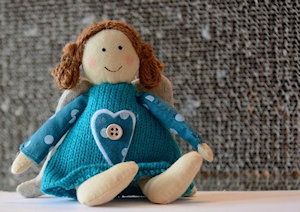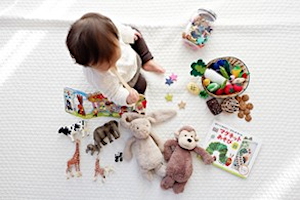4. To help with joining ideas and sentences together and further developing vocabulary
- Focus on one of the activities below for a while so your child has a chance to become familiar with it and the words involved in that activity. Go at your child’s pace.
- Keep activities short.
- If your child struggles to engage in the activities – try bringing their interests into the activity.
ACTIVITIES TO TRY:
Story making game:
- Make and put together:
- a set of character pictures (family members / animals / TV programme characters / occupations e.g. police person or doctor etc.)
- a set of place pictures (e.g. park, shops, swimming pool, seaside, zoo etc.)
- a set of question marks.
- Each person chooses a character, a place and a question mark.
- The adult lays out the cards in order and models how to tell a story:

- Point to the cards in order and say the story e.g. the dinosaur went to the park and what happened….? You might say “he had an ice-cream!”
- Then repeat the story to make it clear.
- Now choose who will say their story next and so on around the group.
- Anything can happen in the ‘what happened’ section so make it fun and accept all attempts even if they are unusual, repeated or acted out rather than said.
Story retelling:
- Find a story your child likes and read it often to model the language for the story.
- You don’t have to read the story word for word, instead you could just talk about what is happening in the pictures.
- Give your child visual cues as you tell the story e.g. point to what you are talking about, use gesture or act out what is happening yourselves or use toys to do this.
- Talk about how the characters in the story are feeling.
- Once your child is familiar with the story see if can they say what is going to happen next if you pause during the story or before you turn the page.
- If they struggle with saying what will happen next give them a choice e.g. “will Peppa eat dinner or go to the park?”.

If your child is not usually interested in books – you could try making a picture story book about them and people they know or using their favourite characters. You could do this by:
- Taking photos of them or their favourite toys (e.g. doll / teddy / figures) doing a sequence of actions that tell a simple story or making a video together about it using a smartphone/tablet.
- You can then pause the video and talk about what is happening or will happen next.

- You could extend the game by making up different endings to the story.
- If your child needs help you could suggest two different endings to choose from.
Category game:

- Gather together objects/pictures of things that all go together for a particular reason e.g. food / drinks / animals / clothes / transport / things that go together because you use them for the same thing (e.g. to eat with or to wear) or because you find them in the same place (e.g. the bathroom or the kitchen).
- Have a few example objects/pictures in two piles so the child has an idea of what the two categories are.
- Have a main pile of objects/pictures or put them in a bag.
- Take turns to sort the objects/pictures and to talk about what you are doing e.g. “cat…it’s an animal”, “bread…it’s something you eat”.
- You may need to model the language a lot, and to use sentence starters e.g. “it’s something you….”, or give your child choices e.g. “is it an animal or something you eat?”.
2-3 step activities:
- Model words such as “first”, “next”, “and then”, “last”, “before”, “after” to describe what you are doing during familiar daily routines with your child (e.g. washing hands, putting on clothes, going to the toilet etc.) or during play activities that involve a few steps (e.g. making something from playdough, painting etc.).
- Model the language lots at first.
- Once your child is familiar with the language then see if they can say what they or you need to do during the activity.
- If they need help you could prompt them by
- starting off the sentence for them
- using a gesture to show them which action comes next
- giving them a choice of two possible answers e.g. “wash or clap our hands”
- You could take photos of the steps involved in a 2-3 part sequence and support your child to put the photos in order and to talk about what is happening.
Why? questions:
- Model sentences with the word ‘because’ in during the day e.g. “I am wearing a jumper because it’s cold”, “I’m going to eat something because I am hungry”, “I’m going to sit down because I feel tired”, “I am wet because it is raining”.
- Once you have modelled the language a lot start to ask your child questions e.g. “why is Mummy wearing a jumper?”, “why is Daddy going to eat something?” etc. When watching TV programmes/ looking at books or photos ask simple why questions about them.
- If your child has difficulty answering ‘why’ questions give them a sentence starter e.g. “Daddy is eating a sandwich because……”. If they need more help than this you could give them a choice of two possible answers.
Last updated20 Jan 2025

